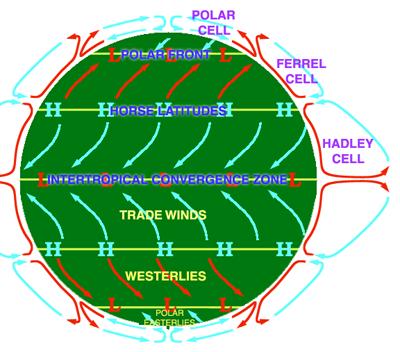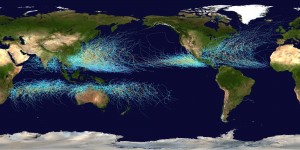The image above shows the predominant winds for the whole world. Most of our sailing will be in the trades, with nearly all of the Pacific crossing in the southeast trades. Where the southest and northeast trades meet, there is an area of light winds, rain, and squalls know as the doldrums or the ITCZ. Its exact location and width varies throughout the year, but in the eastern Pacific it is typically between 5 and 9 degreees north lattitude. Once we make it through the ITCZ (hopefully about half way from Panama to the Galapagos) we should have nice tradewinds all the way to Fiji. In order to get across the ITCZ as soon as possible while also trying to avoid the contrary current near the coast of South America, we’ll likely head south-southwest until we pick up the trades and then change course toward the Galapagos.
The Atlantic hurricane season is officially from June to November. That means that 97% of all storms have occurred during that time period.
Note that no storms have made it as far south as Colon or Panama City.
The Atlantic basin has a very peaked season from August to through October.
The next area we have to worry about is the South Pacific.
The Australian/Southwest Pacific basin begin with tropical cyclone activity in late October/early November, reaches a single peak in late February/early March, and then fades out in early May.
Our goal is to be in New Zealand before the beginning of this storm season, well south and out of the way of storms. There have been two storms in the last ten years that have crossed New Zealand, but we will be tucked away safe in harbor.
We plan to leave New Zealand next May and head on through the Torres Straits and through the Indian Ocean. The next storm season is about the same as the last, so we will be trying to get out of that zone by October.
The Southwest Indian and Australian/Southeast Indian basins have very similar annual cycles with tropical cyclones beginning in late October/early November, reaching a double peak in activity – one in mid-January and one in mid-February to early March, and then ending in May. The Australian/Southeast Indian basin February lull in activity is a bit more pronounced than the Southwest Indian basin’s lull.
That is the world storm seasons in a nutshell. I hope that answers some of the questions people have had.



